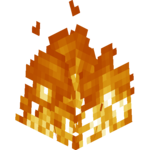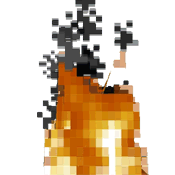
Fire is a non-solid block which produces 15 units of light. It has animated faces on all four sides, and two more faces on the inside in an X shape. Fire makes a crackling sound that can be heard up to 15 blocks away. Fire blocks are only generated naturally in The Nether and in The End (on top of the bedrock that spawns on top of the pillars). The Player can create fire using a Flint and Steel or a Fire Charge. Ghasts and Blazes can also create fire, as can Lava and lightning. Fire spreads naturally to other nearby flammable blocks.
Behavior[]
Flint and Steel is one method used to place fire in the environment. When placed, fire will burn for a short and randomly determined amount of time. If nothing flammable is adjacent to it, the flames will not spread, and will die out. Wood, Wooden Planks, Wooden Slabs, Leaves, Vines, Tall Grass, Wool, Fence, Wooden Stairs, and Bookshelves are all flammable. If you place a bed in The End or Nether and try to sleep it will explode and create fire. Fire can melt Ice, and TNT will detonate if exposed to fire. Fire will burn leaves slightly faster than the other flammable objects, suggesting the game has coding differences between some different types of flammable blocks. Many blocks do not burn away even though they may appear to catch fire. Two notable block types which do not burn away are Wooden Chests and Crafting Tables.
Mobs and players will catch fire when exposed to fire. Fire will obstruct the player's view slightly and they will slowly lose hearts at a rate of ½ heart per second. This is the same rate that the player gains health in Peaceful mode, so fire alone will not kill you in this mode.
Fire can be used to damage or kill mobs without causing them to become hostile to the player. Items or blocks falling into fire will catch light and quickly disappear. This trick can be used to dispose of unwanted materials, but it can also destroy valuable drops before they can be retrieved. Lava can set off TNT, but it may take several minutes to do so, and this usually gives time to clear the lava away before the TNT is triggered.
If a Cow, Pig, or Chicken dies while taking fire damage, it will drop a random amount (0-2) of the cooked version of its usual meat; cows drop Steak, pigs drop Cooked Porkchop, and chickens drop a Cooked Chicken. This can be exploited by the player to not need to cook the meat. With a flint and steel, or a fire-enchanted weapon, all meat yielded will be cooked and useable to its full potential.
Spread[]
Fire will spread over flammable surfaces slowly, causing all the blocks it can reach to burn away. Fire can climb up walls, across floors and ceilings, and over small gaps. More precisely, a fire (or still lava) block can turn any air block that is adjacent to a flammable block into a fire block. This can happen at a distance of up to one block downwards, one block sideways (including diagonals), and four blocks upwards of the original fire source.

An animation of fire
Extinguishing[]
Fire will burn out after a while on its own, however the player may want to extinguish the fire as soon as possible to prevent damage. Punching or hitting the side of a burning block will extinguish the fire block 'attached' on that side. Hitting fire with a tool does not use up any uses for the tool. Placing Water, Sand, or Gravel on the fire will also extinguish it. A player on fire can jump into water to extinguish themselves or use a bucket of water as a portable fire extinguisher by dumping the water at their feet to put out the fire instantly.
Eternal Fire[]
Netherrack, a block found in The Nether, will burn forever when set on fire, unless put out by lava, water or the player. It can therefore be a useful trap or defense material around the player's shelter; though the player should be reminded that while this is quite effective at killing hostile mobs, it's also a potential danger to passive mobs, the player themselves, and any dropped items that fall in the fire will be lost.
Lit Netherrack can be used as an alternative to torches. If the player is running low on Coal, they can use Netherrack and flint and steel instead. Netherrack fire is brighter than a Torch, and can be quickly extinguished. Note that rain won't put out Netherrack fire. Bedrock in the end will also burn eternally.
Trivia[]
- It is possible for lightning to light a surface on fire during thunderstorms, but it will almost immediately be put out by rain. In rare cases in Survival Mode, fire may not get extinguished.
- Though Wood Planks and logs are flammable, they burn up very quickly, making them nearly useless when making a fireplace, bonfire, etc. The only block that burns forever is Netherrack, along with Bedrock but only in the End.
- Entities, such as mobs or items, that are on fire do not emit any light. Mobs also cannot set blocks around them on fire, even if they are flammable.
- Most players choose not to make fireplaces in wooden houses, due to the fact that fire can burn down wood quickly.
- A Minecraft forest fire is much less dangerous than a real-life one. Burning trees in Minecraft can only create the usual one-meter fire blocks, as opposed to the multi-hundred-foot flames, convection winds, and flying embers that a powerful real-life wildfire can create.
- Passing through a Nether Portal while on fire will no longer show the fire, but you will technically still be on fire.
- Fire is the material used to create chain armor, however it is impossible to have fire in your inventory without the use of modding the console.